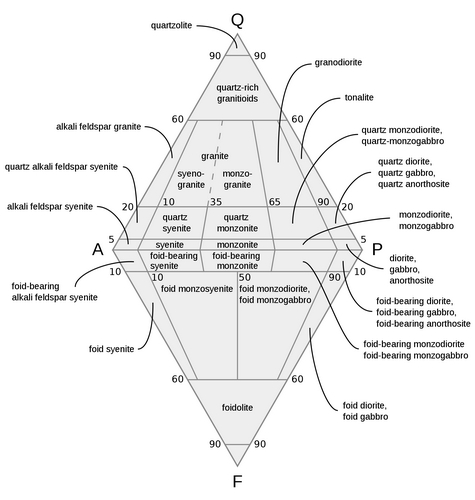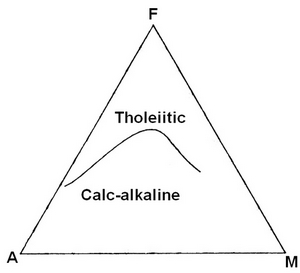Adirondacks: Short Glossary
-anorthosite: mostly plagioclase, very little quartz, less than 10% mafic minerals (usually pyroxene)
-andesine: a solid solution of albite (NaAlSi3O8) and anorthite (CaAlSi3O8), i.e. a plagioclase, with 30-50% anorthite and 50-70% albite.
-gabbro: similar to anorthosite, with much more mafic minerals, and some olivine
-mangerite: an orthopyroxene-bearing monzonite
-charnockite: an orthopyroxene-bearing granite
-granite, granodiorite, monzonite, syenite, tonalite compositions can be seen on the QAPF diagram below
-calcalkaline rocks: igneous rocks relatively rich in alkalis and poor in iron as shown on the AFM diagram below
-calcsilicate: a metamorphic rock consisting mainly of calcium-bearing silicates such as diopside (CaMgSi2O6, a clinopyroxene) and wollastonite (CaSiO3), and formed by metamorphism of impure limestone or dolomite
-marble: a metamorphic rock composed of recrystallized carbonate minerals, mainly calcite (CaCO3, found in limestone) or dolomite (CaMg[CO3]2, present in dolostone)


The QAPF diagram (left), as defined by the IUGS, classifies plutonic rocks according to the percentages of quartz (Q), alkali feldspar (A), plagioclase (P), and feldspathoid (F). The mafic mineral content is not indicated in this diagram. Source: -xfi- (Own work) [Public domain] via Wikimedia Commons.
The AFM diagram (right), shows the difference between tholeiitic and calc-alkaline igneous rocks, by their relative percentages of alkalis (A = Na2O + K2O), iron (F = FeO *, i.e. the total of all iron oxides), and magnesium (M = MgO).
